Are you an avid bird watcher wanting to know how to identify more birds? Or maybe you love seeing the flying creatures in your daily life and want to know what they’re called. Either way, you’ve come to the right place.
There are many birds with white heads that exist all around the world. Here are 30 of them and how to identify them successfully.
Belcher’s Gull

Belcher’s gulls have red- and black- tipped beaks.
©iNaturalist – License
The belcher’s gull is also known as the “band-tailed gull” depending on which area of their habitat you’re in. During breeding season, these animals have white heads, chests, and undersides. Their wings are brown or gray and so their tails. They have orange legs, webbed feet, and black eyes.
You can find these gulls along the Pacific coast of South America, from northern Peru to northern Chile.
Pacific Gull

The beak of the pacific gull is wider than other gulls with red-tipped beaks.
©Flickr – License
The pacific gull is another of the many birds with white heads. They have white heads, chests, and underbellies. Plus, the white feathers of their head fan out slightly in the back. Their wings are dark gray with white and brown tips. They also have pale yellow legs and large webbed feet.
Their habitat range is along the coasts of Australia.
Ross’s Gull

Ross’s gulls have short, black beaks.
©Flickr – License
Among birds with white heads, the Ross’s gull lives in Antarctica and very rarely visits North America. In breeding season, these birds have white feathers that are dusted with light gray. Their heads are white, and some also have a dark ring around their neck.
These birds have short, red legs and a pink wash on their chest and underbelly.
Ivory Gull

Ivory gulls have black, hooked beaks.
©Agami Photo Agency/Shutterstock.com
The ivory gull is another species of seagull that made it onto this list. Because there are so many, they can be quite difficult to identify. Not the ivory gull.
Unlike other species, the ivory gull is completely white. In some cases, they’ll have speckling on their face and tail. Their legs are short and black. They also have large, webbed feet.
These gulls breed in the high arctic before going down to Greenland. The animals stay quite far up north though and are rarely seen in the United States.
Slaty-Backed Gull

The slaty-backed gull has a black tip on its yellow beak.
©Flickr – License
Among gulls, the slaty-backed is another species of white head birds. In addition, these avian animals are larger than many other species of gull. They spend their breeding season on the north-east coast of the Palearctic.
The birds travel widely during nonbreeding seasons, in search of food and fair weather.
You can recognize them by their white heads, chests, and underbellies. Also, keep an eye out for mottled or dark gray wings if you want to spot a slaty-backed gull. Plus, they have pale orange short legs and webbed feet.
Iceland Gull
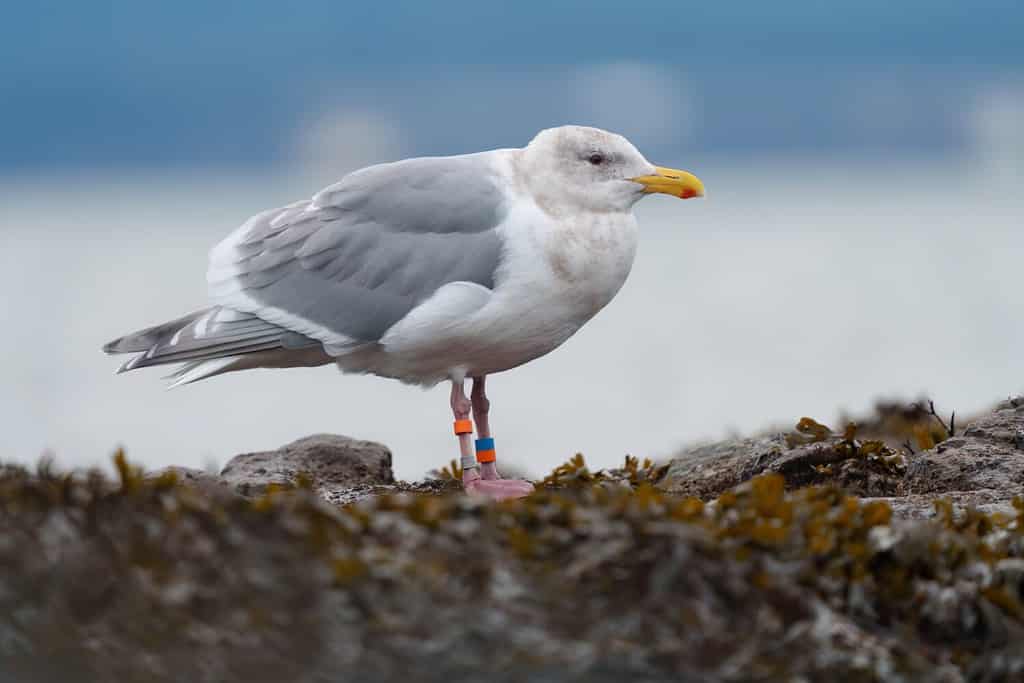
Iceland gulls have a red tip on the bottom of their beaks.
©2009fotofriends/Shutterstock.com
The Iceland gull is easier to identify than most other gulls because it looks quite different. These birds have a white and light gray head, chest, and underbelly. Their wings are mottled with white and gray. The Iceland gull also has a dark tail and gray legs.
Though you might think Iceland gulls only live in Iceland, they do not. They breed in Greenland and also within the Arctic regions of Canada. The birds go to Iceland during the winter.
California Gull

A California Gull displays breeding plumage and the bright red spot on its beak to indicate that it is eligible.
©Ken Hoehn/iStock via Getty Images
A medium-sized bird on this list, the California gull might be one of the easiest to recognize if you live within the continental United States. These birds are shorter and squatter than some other species. Plus, they have shorter yellow legs.
The head, chest, and underbelly of the California gull is white while their wings are light gray. In addition, their tails are black.
In the winter, you’ll see these animals along the Pacific coast of North America. Otherwise, they live in marshes and around lakes in the western U.S.
Herring Gull
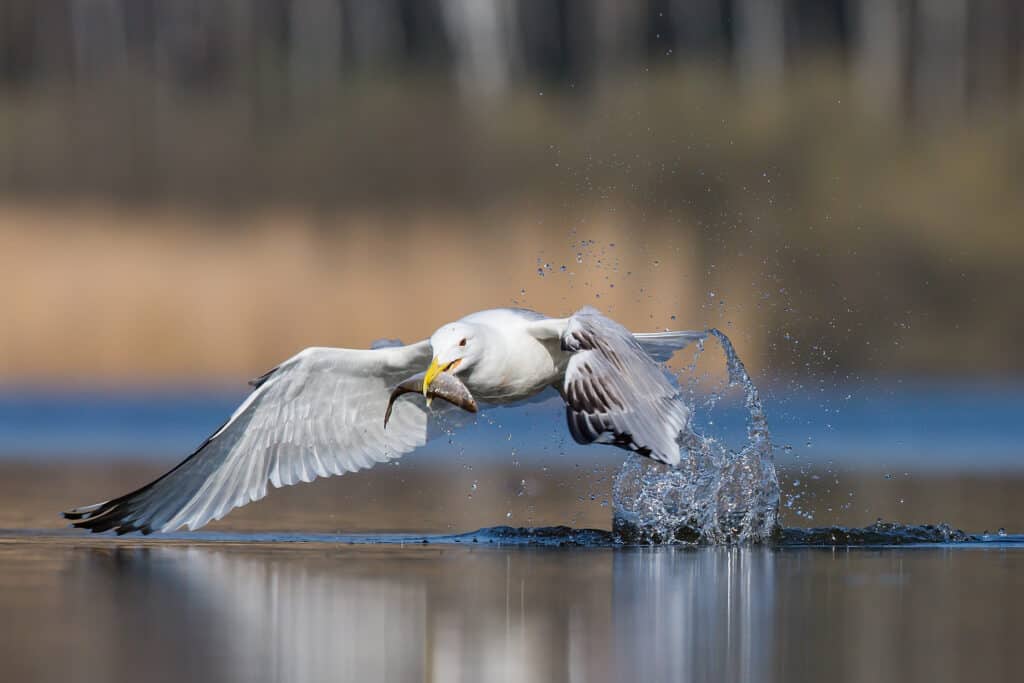
Seagulls are sometimes considered annoying and aggressive birds.
©Lukas Pavlacik/Shutterstock.com
Another easy to recognize animal among white head birds is the herring gull. These are the birds that most people think about when they hear “seagull”. The herring gull has a white head and underpart. Their wings are light gray while their tails are spotted with black.
The animals also have pale yellow legs and webbed feet. You will be able to see the herring gull in various parts of the world, as they have a large migration pattern. They permanently live in England, Iceland, Ireland, and on the North Sea shore.
Kelp Gull

Kelp gulls have red on the bottom part of their yellow beaks.
©Jannie Peyper/Shutterstock.com
Depending on the region you’re in, the kelp gull is also known as the “Dominican gull” or the “southern black-backed gull”. These animals have white bodies overall with dark brown wings and a tail. Plus, their wings have distinct white spotting on the ends. They also have long, greenish-yellow legs.
They are a medium-sized gull that lives in South American, parts of Australia, and New Zealand.
Black-Tailed Gull
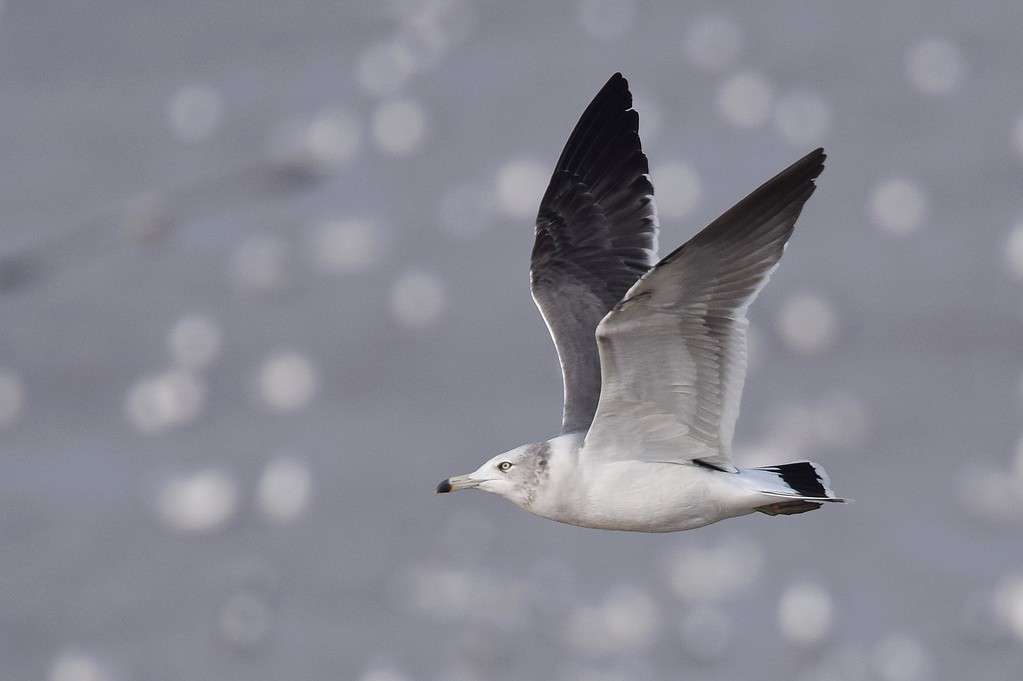
Black-tailed gulls have black tips on their gray beaks.
©Flickr – License
When it comes to birds with white heads, black-tailed gulls are quite easy to recognize. They have white bodies, wings that go from light gray to dark brown, and dark brown tail feathers.
These avian animals have pale yellow legs with wide webbed feet. Sometimes they will look similar to the kelp gull, but their wings will be lighter gray. In these cases, they will also have a black and red ring around their beak.
The black-tailed gull lives on the shores of East Asia.
Cattle Egret

Cattle egret sometimes have black tips on their orange beaks.
©Richard A McMillin/Shutterstock.com
The cattle egret is small compared to other kinds of egret. You can also distinguish these animals by the light pink wash along their chest and head. This pink coloring is only present in some animals.
Otherwise, the cattle egret has shorter legs than other egrets, and a shorter beak. They will also have fluffier feathers and what looks like a little beard under their beak.
Chinese Egret

The Chinese egret has a yellow beak.
©iNaturalist Taiwan – License
With its distinct feathers flowing off its white head, the Chinese egret might be one of the first to pop into your mind when you think of the bird species. Other than the flowing feathers on its head and chest, the animal has long, black legs.
For those wanting to find the bird in the wild, they live in South Asia. They go to coastal Russia, mainland China, and both Koreas to breed.
Little Egret
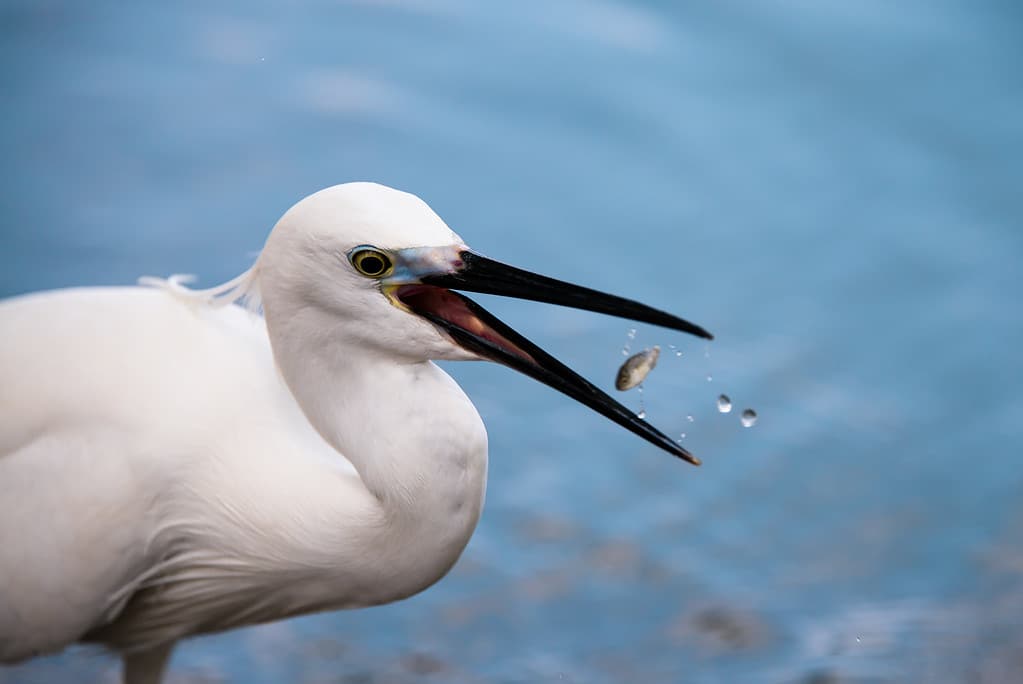
Little egrets have black beaks.
©Flickr – License
Among the smaller species of birds with white heads, the little egret usually has one long feather on its head. Its entire body is white while it has legs that are stockier and shorter than other egrets.
These herons live in wetlands throughout Asia, Europe, Africa, and Australia. Humans recently spotted them in the United Kingdom.
Great Egret
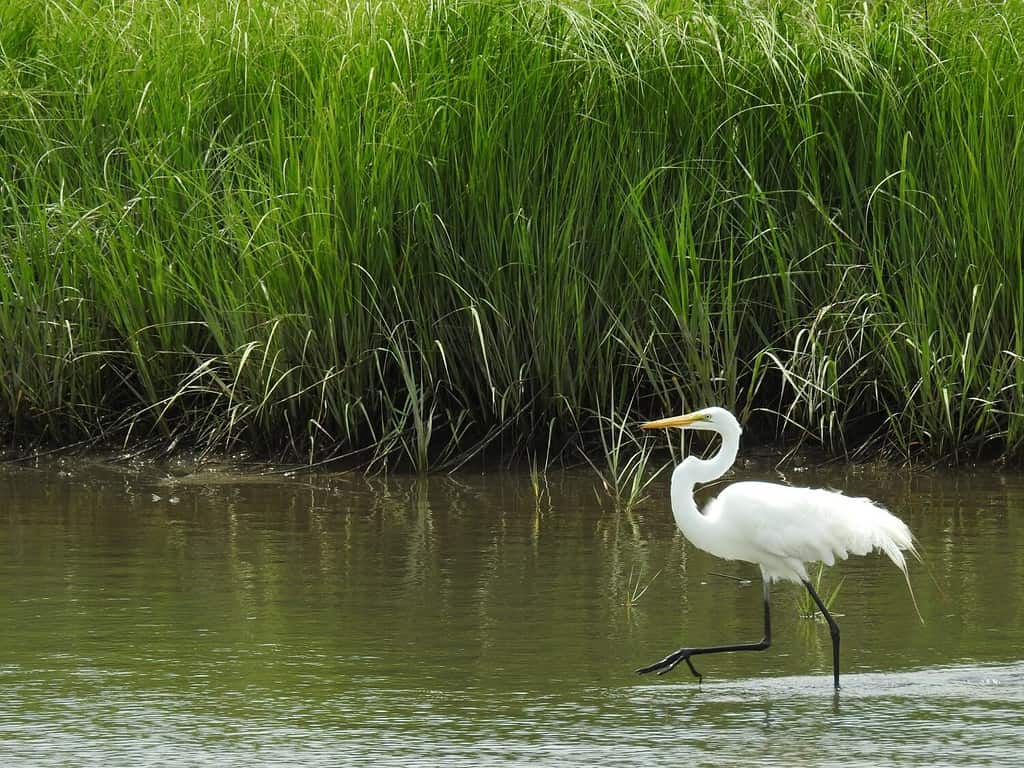
Great egrets have yellow beaks.
©Scenic Corner/Shutterstock.com
You might also think of the great egret when someone mentions the species of bird. These animals have a more defined, thinner S-shaped neck than other egrets. Unlike other egrets, they do not have flowing feathers off their heads or chests. Their black legs are thinner and longer than other egrets.
The great egret lives all around the continents of America, Asia, and Africa. They are also common in southern Europe.
American White Ibis
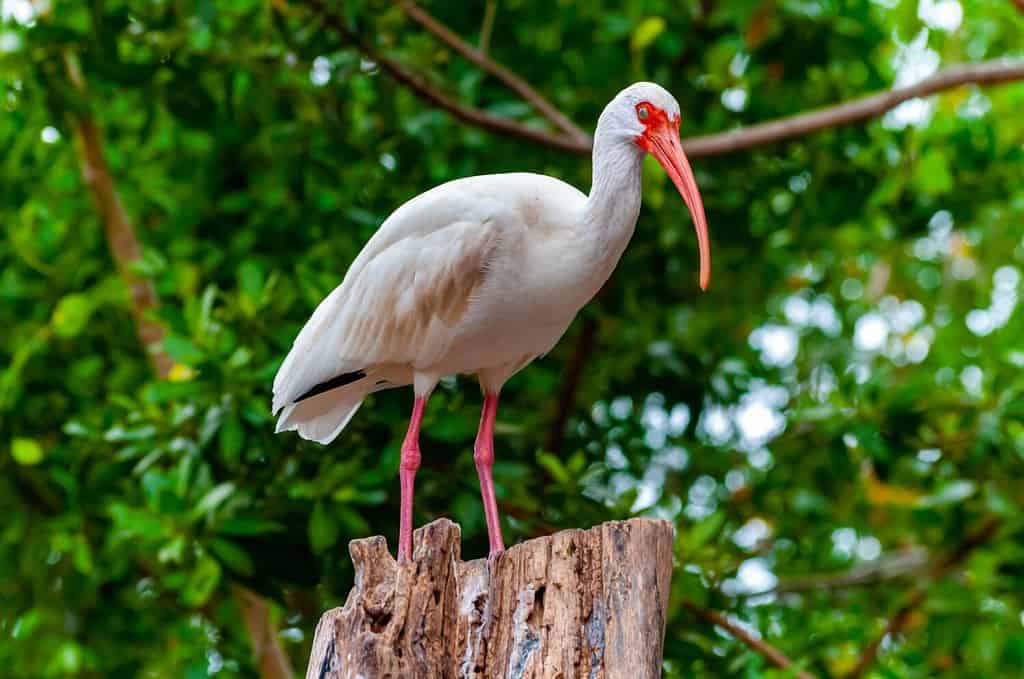
The American white ibis has an orange beak.
©Oleg Kovtun Hydrobio/Shutterstock.com
Sometimes people mistake the American white ibis for a different species among birds with white heads, such as a cattle egret. The ibis is recognizable by its bright orange beak and legs. Otherwise, the animal is completely white. They are also generally shorter than herons.
The American white ibis lives throughout the United States.
Whooper Swan
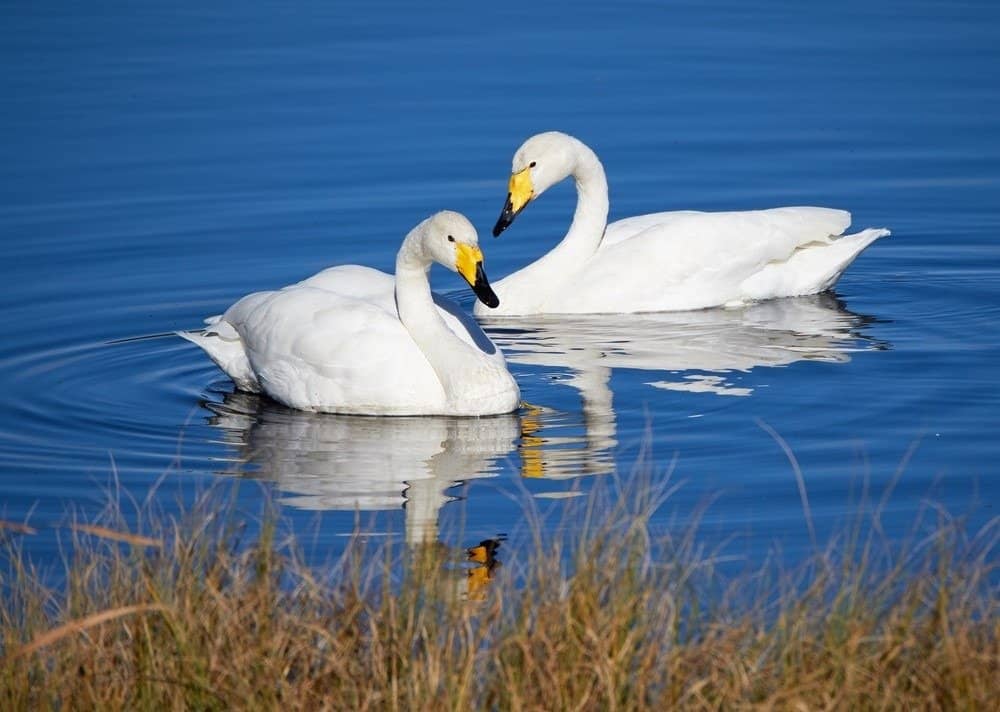
Whooper swans have yellow and black beaks.
©Teemu Tretjakov/Shutterstock.com
The first swan species on this list, the whooper swan is another bird with a white head. These animals resemble the trumpeter swan but have shorter legs and longer necks. Also, the color of their legs is black.
The avian animals can be found throughout Russia, in Japan and China, and in parts of Europe. The whooper swan is also seen in parts of western Asia.
Mute Swan
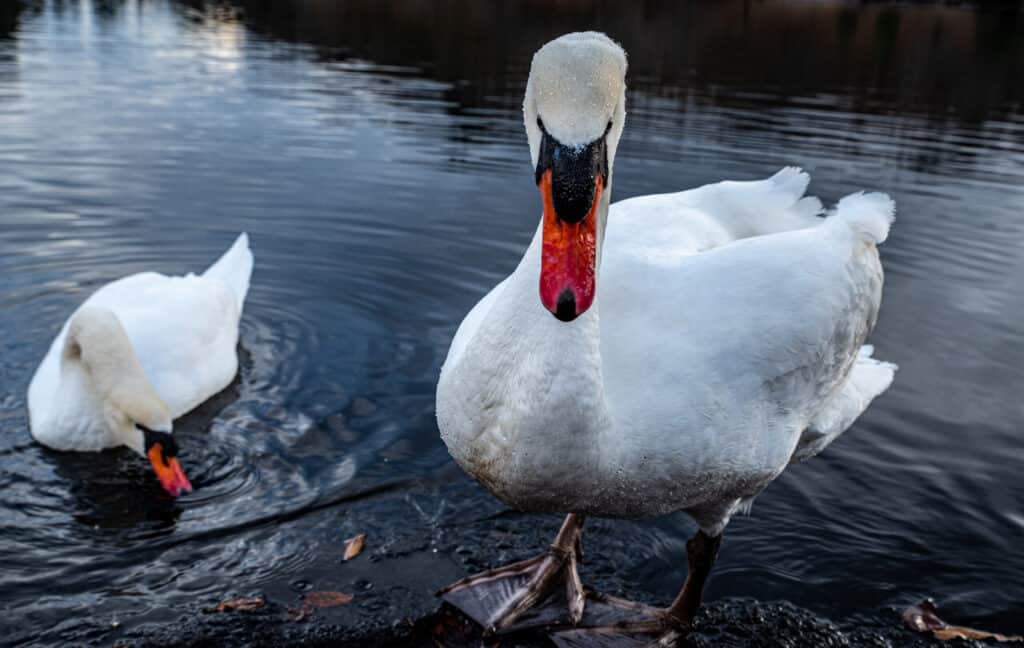
Mute swans have orange and black beaks.
©TETSU Snowdrop/Shutterstock.com
When you think of swans, you are probably thinking of the mute swan. These animals are probably one of the most well-known among birds with white heads. They are quite large, completely white, and have stocky, black legs. Their webbed feet are also large. Sometimes their heads will have a light brownish hue.
While the animals are native to Eurasia and Africa, colonizers brought them to North America and other parts of the world.
White Tern

White terns have completely black beaks.
©iStock.com/MarcStephan
A small animal, white terns have completely white bodies, in addition to being birds with white heads. They are long, small, and have an average lifespan of 36 years. Their legs are short and black.
To find a white tern, simply walk along a beach on an island in the Pacific or Atlantic Oceans. They also live on islands in the Indian Sea.
Black-Legged Kittiwake
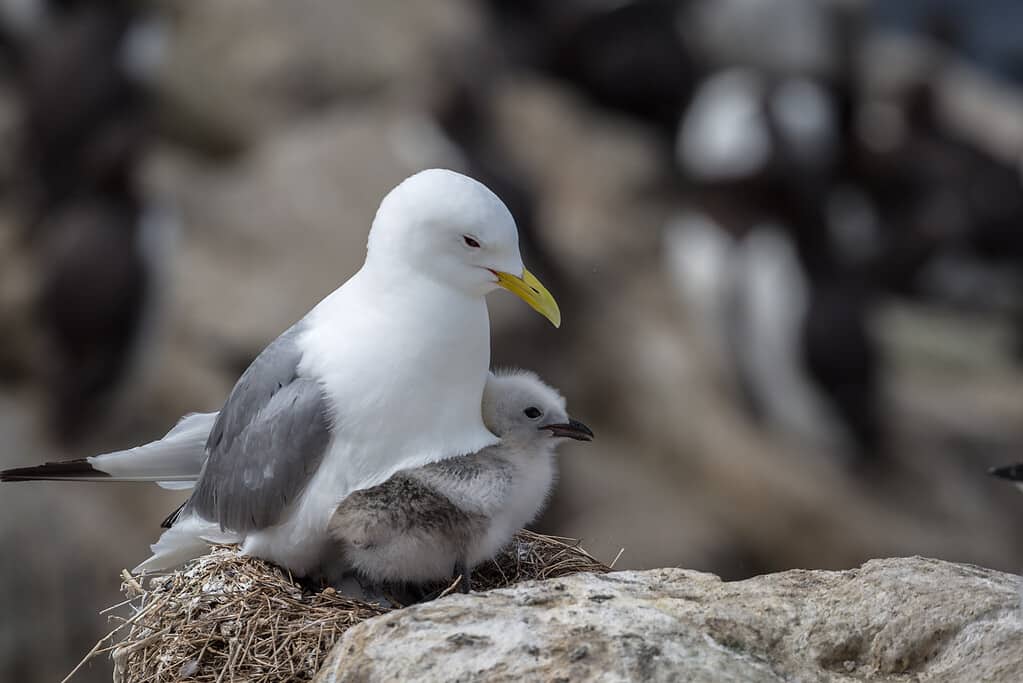
Kittiwakes have yellow, curved beaks.
©Andy_Oxley/ via Getty Images
Another coastal species among birds with white heads is the black-legged kittiwake. They have white heads and bodies with grey wings and stocky, black legs. The kittiwake has a sub-species that looks exactly the same, except the legs are red.
You can find these animals along both coasts of the Atlantic Ocean.
Northern Fulmar
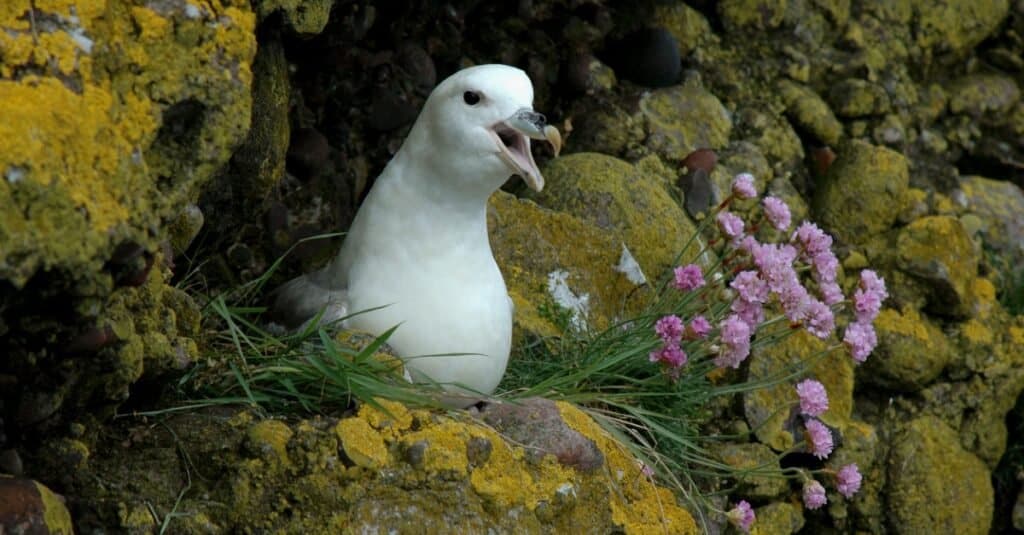
The birthing northern Fulmar only returns to land to build a nest, lay a single egg, and feed its flightless young.
©iStock.com/Michel VIARD
The northern Fulmer is sometimes called the “Arctic Fulmar” depending on which region you’re in. In addition to a white head, these birds have gray wings, blue-gray legs, and a hooked bill that is thick and yellow.
You can spot these creatures in subarctic regions along the north Pacific and Atlantic Oceans.
Snow Bunting

The snow bunting has a short, black beak.
©xpixel/Shutterstock.com
The snow bunting is considered a passerine bird. In other words, they are a perching bird. The animal can get quite large and has long wings. Sometimes they will have a brown tint on their head, but most of the time it is completely white. Their wings and legs are dark.
The bunting prefers to walk along the ground in central Scotland, the Cape Breton Highlands, and along the Saint Elias Mountains.
Smew
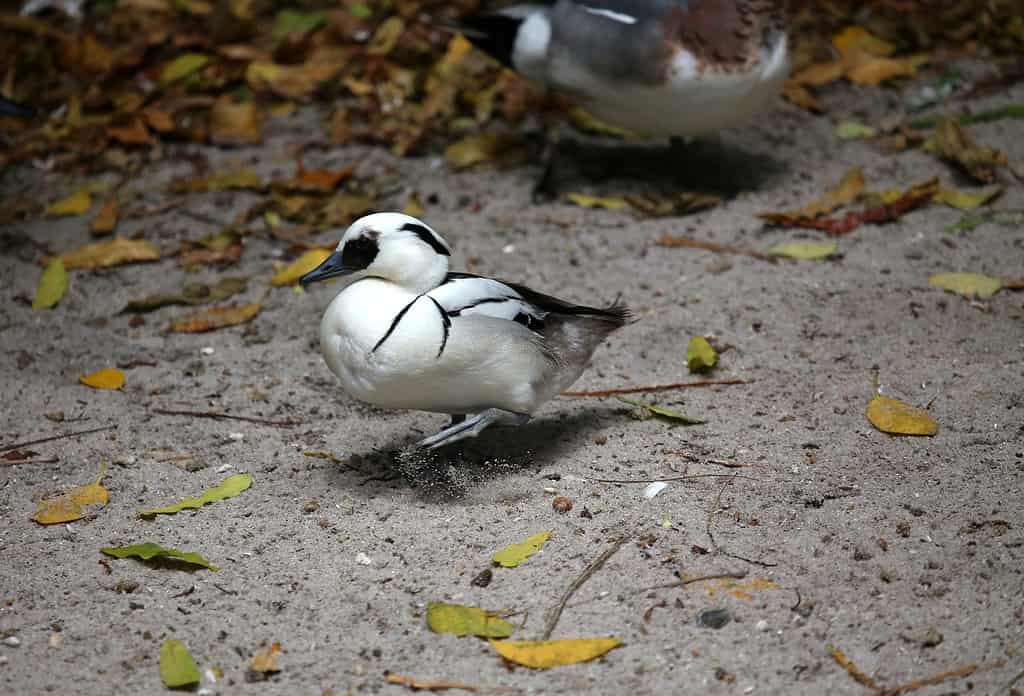
The smew is a species of duck with a completely black bill.
©flickr – License
The smew is a duck that is mostly white, which black around its eyes, on the back of its head, and on its wings. They have light gray, short legs and large, webbed feet. The birds are migratory and go between the Palearctic and the boreal forests of Europe.
American White Pelican
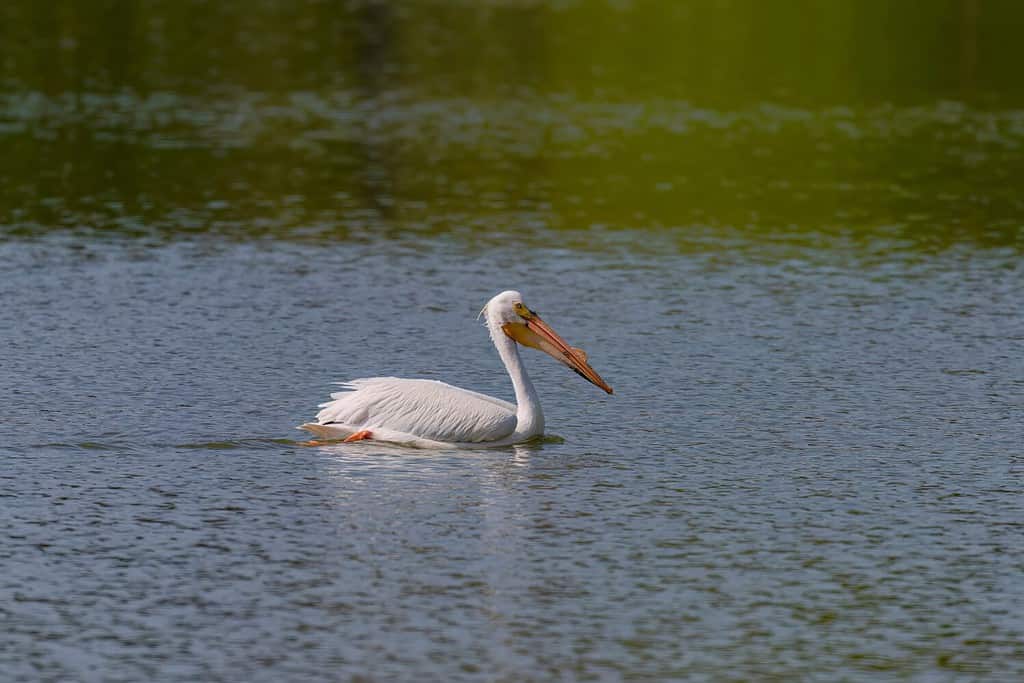
The American white
pelican
has a large, orange beak.
©Karel Bock/Shutterstock.com
Among birds with white heads, the American white pelican will probably be one of the easiest to recognize. The animal is quite large, with a long, protruding beak. Under its beak will be a flap of skin that extends when they catch fish. The bird has orange, short legs and a dusting of orange around its eyes.
Humans can find them throughout Central, South, and North America. They are also the largest native bird in America.
Black-Bowed Albatross
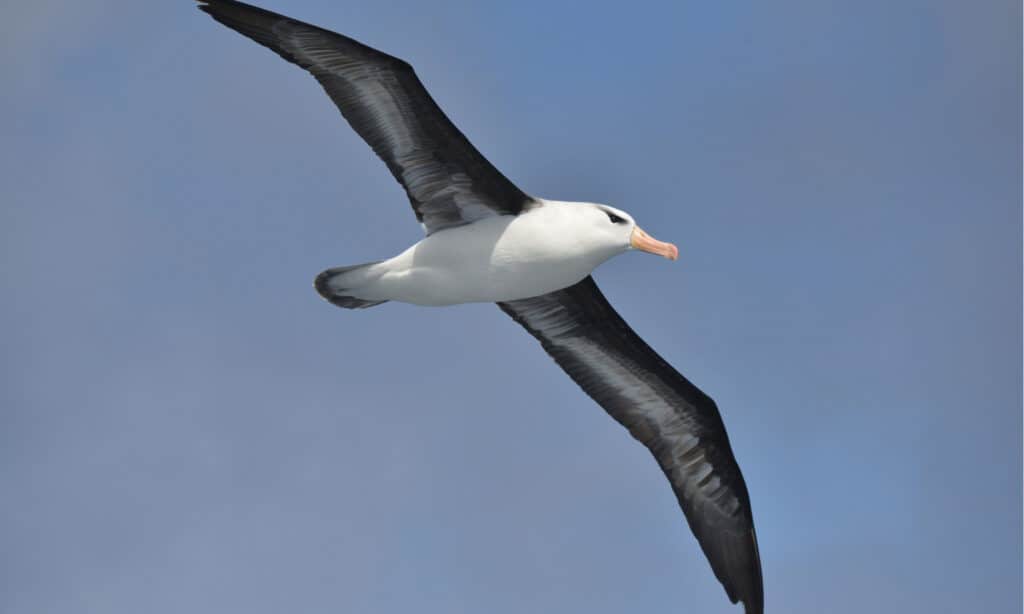
The black-bowed
albatross
has a yellow, hooked beak.
©Vladimir Strnad/Shutterstock.com
Though they are often related to bad luck, the albatross is a bird that keeps to itself along the southern hemisphere. They roam along the coasts of South America, Southern Africa, and Australia.
You can distinguish them from seagulls and other birds with white heads based on the black smudge on their eyes and their long, dark wings.
White-Tailed Kite

The white-tailed kite has a short, hooked beak that is black and yellow.
©rancho_runner/iStock via Getty Images
These small birds of prey are another among birds with white heads. The white-tailed kite lives in western North America and in parts of South America. They have white bodies, heads, and light gray tails. Their wings go from light to dark. The kite also has short orange legs.
Snowy Owl
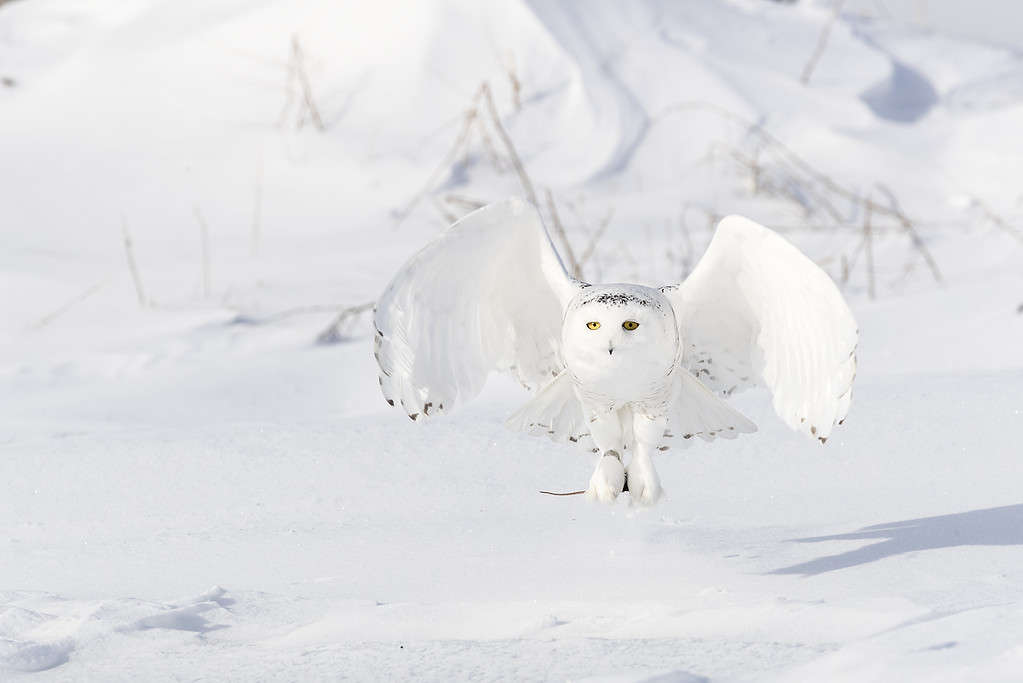
Snowy owls have small, black beaks.
©Karyn Schiller/iStock via Getty Images
The snowy owl is another easily identifiable species on this list. They are completely white with spots of brown along their wings and on their head and tail. The animals have white and fluffy feet with talons protruding to help them catch pray.
In some regions, the snowy owl is the “Arctic owl” or the “Polar owl”. They live in the tundra regions of North America and the Palearctic.
Bald Eagle

Bald eagles
have wide, yellow, and hooked beaks.
©PHOTOOBJECT/Shutterstock.com
The bald eagle is the national bird of the colonial empire of the United States, and easily recognizable. The eagle has a bright white head and completely brown body. The tail of the eagle is white or gray if it isn’t brown. They have bright orange talons.
The animal resides on the entire continent of North America.
White-Headed Woodpecker
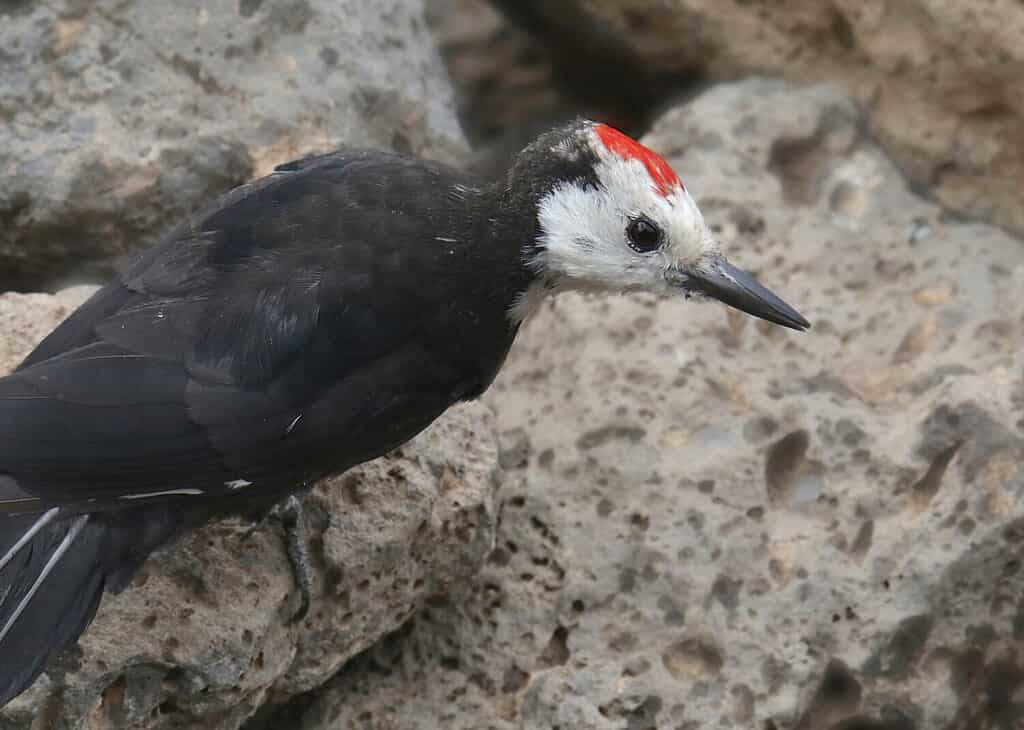
The white-headed woodpeckers have straight, black beaks.
©vagabond54/Shutterstock.com
Among birds with white heads, the white-headed woodpecker usually lives in mountainous regions. The adults have bright white heads and necks while the rest of their bodies are dark brown or black. Their wings have white patches underneath. Inseminating birds have a bright red patch on their forehead.
The white-headed woodpecker lives in the southwest region of North America.
White-Headed Marsh Tyrant
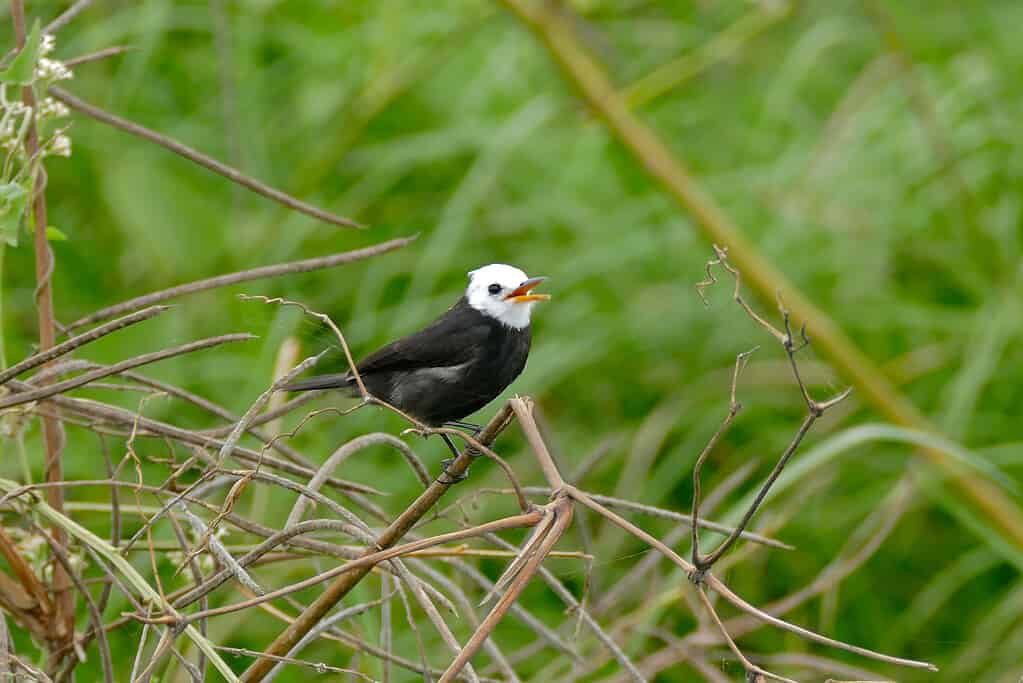
The white-headed marsh tyrant has a straight, yellow beak.
©flickr – License
The white-headed marsh tyrant is an agile flier that lives in the northeast area of South America. They have a distinct white head and throat. The rest of its body ranges from dark gray to black. Sometimes, the marsh tyrant will also have a black band around its eyes.
Another avian animal common within northeast South America, the white-headed marsh tyrant will be easy to spot once you know what to look for.
Black and White Hawk Eagle

Black and white hawk eagles have hooked orange beaks with black on the tip.
©NaturaLista Mexico – License
The black and white hawk eagle lives in parts of central America and northern South America. They have bright white plumage on their heads and often along their chests and underbellies. Their wings and tails are dark brown. The hawk eagles also have yellow, short talons.
Summary of 30 Birds with White Heads and How to Identify Them
| Bird Name | Coloring | |
|---|---|---|
| 1. | Belcher’s Gull | White head and chest, dark tail, wings white and dark. |
| 2. | Pacific Gull | White head and chest, brown wings and tail. |
| 3. | Ross’s Gull | White head and body, gray wings, dark ring around neck. |
| 4. | Ivory Gull | White head and body with black, brown, and gray speckles near the beak and on the tail. |
| 5. | Slaty-Backed Gull | White head and chest, gray and brown speckled wings, brown tail. |
| 6. | Iceland Gull | White and light gray head and body and wings, brown tail. |
| 7. | California Gull | White head and chest, gray wings, brown tail. |
| 8. | Herring Gull | White head and chest, gray wings with brown tips. |
| 9. | Kelp Gull | White head and chest, dark brown wings with black tips. |
| 10. | Black-Tailed Gull | White head and chest, gray wings, black tail. |
| 11. | Cattle Egret | White head, body, and wings. |
| 12. | Chinese Egret | White head, body, and wings. |
| 13. | Little Egret | White head, body, and wings. |
| 14. | Great Egret | White head, body, and wings. |
| 15. | American White Ibis | White head, body, and wings. |
| 16. | Whooper Swan | White head, body, and wings. |
| 17. | Mute Swan | White head, body, and wings with black patches around eyes and beak. |
| 18. | White Tern | White head, body, and wings, black patch around eyes. |
| 19. | Black-Legged Kittiwake | White head and chest, gray wings, brown tail. |
| 20. | Northern Fulmar | White head and chest, gray wings, and brown tail. |
| 21. | Snow Bunting | White and gray head, white chest, brown, white, and gray mottled wings and tail. |
| 22. | Smew | White and black head, white chest, and gray, black, and white wings and tail. |
| 23. | American White Pelican | White head, body, and part of wings, black on tips of wings. |
| 24. | Black-Bowed Albatross | White head and chest, dark brown wings. |
| 25. | White-Tailed Kite | White head, chest, and tail, gray and brown wings. |
| 26. | Snowy Owl | White head with some brown spots, brown spots on body, tail, and wings. |
| 27. | Bald Eagle | White head, brown body, tail, and wings. |
| 28. | White-Headed Woodpecker | White head with red patch, dark body, wings, and tail. |
| 29. | White-Headed Marsh Tyrant | White head, dark body, wings, and tail. |
| 30. | Black and White Hawk Eagle | White head with dark patches around eyes, dark wings and tail, mottled body. |
The photo featured at the top of this post is © Jack Molan/Shutterstock.com
Thank you for reading! Have some feedback for us? Contact the AZ Animals editorial team.






